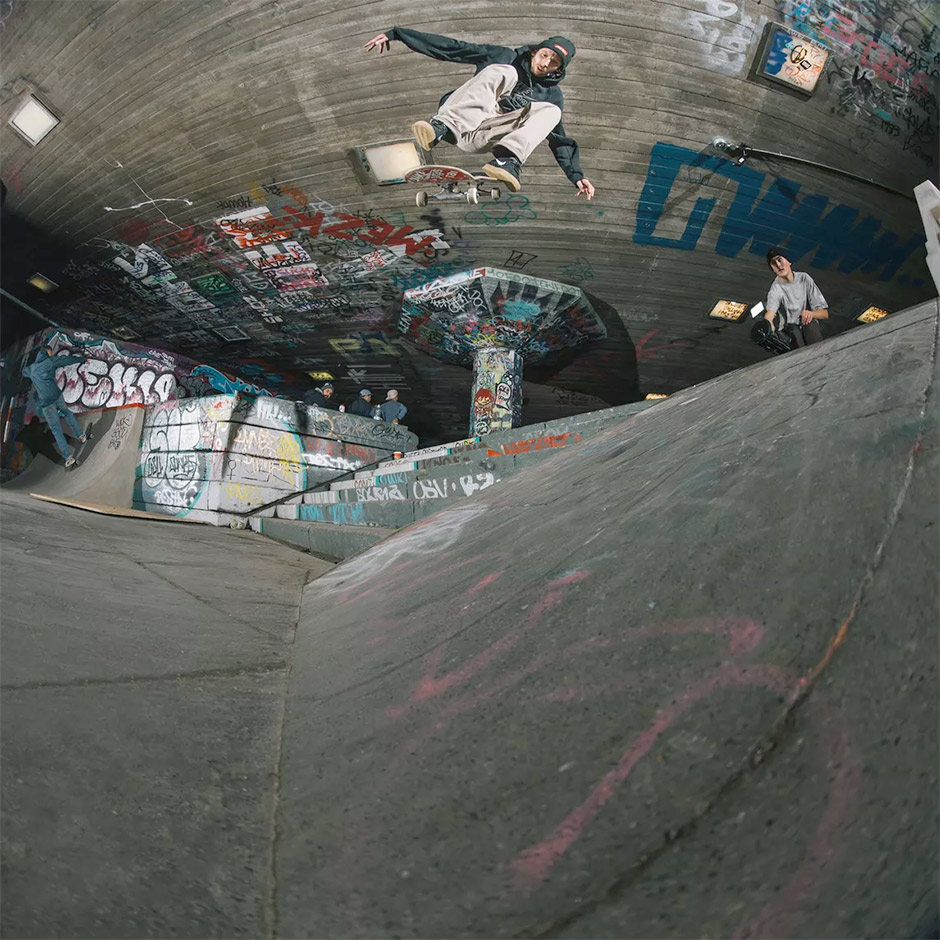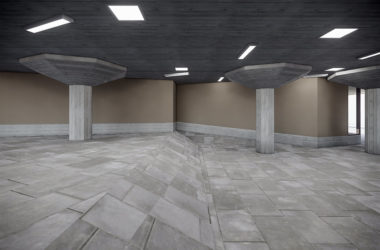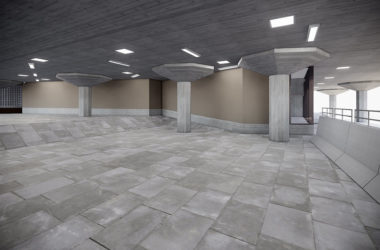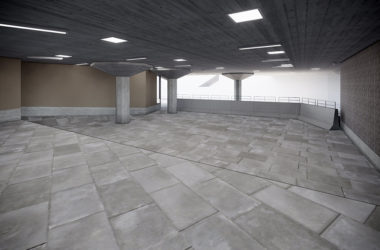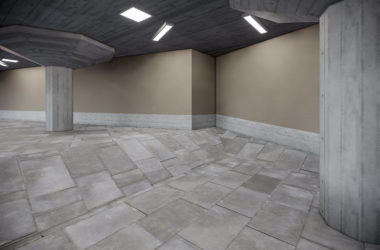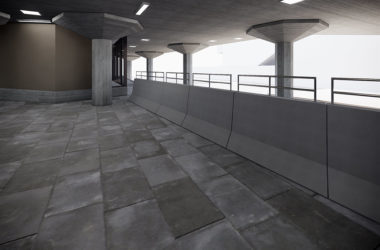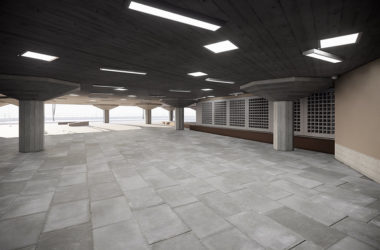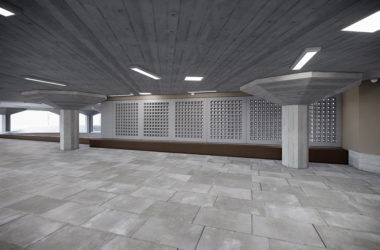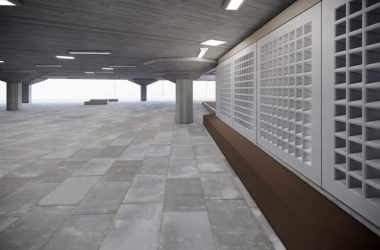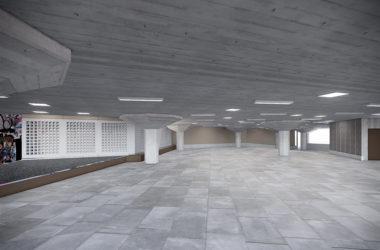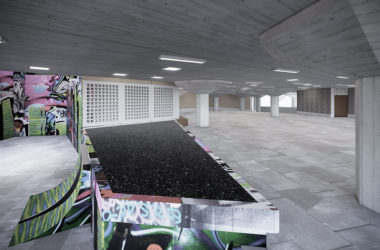Welcome to the Long Live Southbank Interview, this is the full story of what this incredible team have achieved…

Words and interview by Ben Powell. Slam team rider Blondey McCoy. Nosegrind tail grab for the people. PH: Horse
It is with a huge amount of pleasure, and an equally huge amount of pride, that we present to you the following interview with LLSB heads Stuart Maclure and Louis Woodhead on the eve of what must rank as one of the greatest collective achievements in British skateboarding history. What began only 6 years ago as a reaction to plans to obliterate five decades of cultural history from the Undercroft; has evolved over that time to stand as a testament to the sheer force of determination that resides within skateboard culture.
The back-story to the current situation is multi-layered and involves innumerable people, all drawn together under the banner of preserving and celebrating the space underneath The Royal Festival Hall.
Since its inception, LLSB has striven tirelessly to prove beyond doubt that the space beneath some of London’s most celebrated cultural institutions was just as important, just as valuable, and just as worthy of preservation as the world that lay above.
From organising and fund raising; to generating an unprecedented amount of support for the preservation of the Southbank that we, as skateboarders, know; right through to the reclamation of a huge amount of space that the interview below discusses – one thing is undeniable: LLSB have created a movement that has successfully argued for the recognition of the inherent value of living, breathing culture in the city of London in a way that arguably, no other similar organisation has managed before.
Whether you skate Southbank regularly, or you’re somebody who passes through once or twice a year – this victory is still yours to celebrate and the lessons learned during the campaign have transferable value to all related endeavours moving forwards into the future.This is no ‘us and them’ dichotomy either – the success of LLSB represents an institutional embrace of our beloved pastime and a final and indisputable recognition that skateboarding adds something special and magical to the fabric of the city of London.
All praise to every single person who manned the tables. All praise to every single filmer and photographer who helped to document the culture that lives in the Undercroft. All praise to every single person who ever donated money, bought merchandise or helped to spread the message of LLSB in whatever way. This is a victory that every single skateboarder across the globe should be extremely proud of.
Anyway, enough with the laudatory introductions – read on and find out about what’s coming and how it was achieved.
You can make history – never forget.
So, LLSB has reached a pivotal point, which we’ll discuss later in this interview, but for the sake of getting everyone reading up to speed with how you’ve got to this point – can we get a brief overview of the history of LLSB to date first? When did it officially begin, what were the major challenges of getting the campaign up and running from the outset (logistic/political/cultural) and what have been the tipping point moments along the way to today’s situation?
Louis Woodhead: Long Live Southbank (LLSB) was formed in April 2013 in response to a proposal that would have turned the space into coffee shops and restaurants. I got involved about five months later, so my experience of the very early days is second hand, but even then it was still very frantic.
The sheer scale of the challenge facing LLSB in the first year was huge, but we had a huge feeling of momentum as well. We managed to gather the most planning permission objections in British history, which is pretty unreal.
It took a lot of commitment to get a legal guarantee for the space’s future in September 2014. In less than a year and a half, we’d taken one of Europe’s most important skate spots from the edge of redevelopment to a position of safety in perpetuity. We’d always talked about the second step being to restore sections of Southbank that were closed off in 2005, so in the autumn of 2014 we sat down and started taking this a bit more seriously. We’d gained quite a lot of political clout and were working at a pretty high professional standard, even though we never had an office, or even any storage space for stock. We researched and wrote a series of reports, largely for the Southbank Centre who have control of the site, entered into negotiations, and by early 2017 we were in a position to submit a planning application.
Stuart Maclure: Since then, some major tipping points were getting the initial planning permission in June 2017 and the subsequent separation of the restoration and education centre side of the project in mid 2018. The award of each of the major grants constituted big steps forward, as well as finalising the technical designs. We’re finally close to appointing a contractor to carry out the works, which is huge! It’s really mad that we’re finally ready to get building…
Video by Adam Todhunter & Feilden Clegg Bradley Studios
How many people are there currently working for LLSB? How many full-time versus part-time and voluntary? What do your own roles entail on a daily basis?
L: Currently we have a pretty broad team of SB locals who cover the table, selling our merchandise and spreading vibes every weekend. Behind the scenes we only have two full time members of staff. Stu and Matt (Nelmes) are an absolute blessing for London’s skate scene, specialising in overseeing the architectural and construction side, and the day-to-day running of LLSB. I’ve gone down to part time now, and I mainly look over the fundraising, although to be honest we are all pretty big on multi-tasking. We also have Sonny managing our online shop, stepping in for George Toland who’s busy taking photos of alligators deep in Central America.
S: Our day-to-day workload varies a lot depending on the focus of that week/month and we work together as much as possible to make group decisions and share the workload. Some of our days will be spent answering emails and writing fundraising applications, but other days we’ll be busy organising events, in interesting meetings or designing new product. The project always keeps us on our toes.
Before we talk specifics – what’s the fundraising status of LLSB right now? How far away from the final 900k total are you as we speak?
L: We’ve been fundraising since June 2017 and since then we’ve raised over £850,000. Some funders have conditions involved, and there is an underwriting covering a portion of the project, which makes it all quite complex. Effectively we’re still fundraising for the final portions, but we’re in a position to start moving ahead, appointing contractors and starting to schedule in the actual build.
So fund-raising is still active and ongoing then?
L: Indeed it is. Please do get in touch if you’d be interested in supporting! Contact us via [email protected]

Mark Gonzales frontside pivot at a Southbank fundraiser. Ph: Horse
Can you break down the financial side of things for us please as it seemed as though there had been some confusion as regards costs/funding levels as you moved towards the current reclamation plan – what money is needed to pay for what exactly?
L: So all of the money that we’re raising is for the restoration of the little banks, and a large proportion of the sections of Southbank that were closed in 2005. Cost estimates have gone up and down a few times over the last year. We now have final quotes back after tender, which come in at £700,000.
S: We launched with an initial fundraising figure of £790,000, which was based on an initial costing and did not include all the other works needed to get through planning, design, construction and evaluation.
Since the first budget was drawn up, we commissioned some more accurate cost consultancy and design work to inform the tender process. This figure was higher because we had to factor in additional costs including planning consultancy, engineering consultancy, architectural consultancy, the evaluation and reporting of the project, (which is a condition from our funders), and the demolition and removal of the workshop and materials in the old space.
Since phasing the skate space to start as soon as possible whilst Southbank Centre fundraise for the education centre, we also have to work on foundations for the education centre, which is part of this build.
We had to budget for site testing to determine the makeup of the ground and cables, which is complete now. These surveys were key to do as soon as possible because if we waited until the construction phase it would cost much more and put major delays for the rest of the build.
Due to the building being constructed in the 1960s and changing so much over time with little to no records, it’s proving quite costly to avoid all the major cables and to know exactly what we are building on. Simply put, the overall project cost of £1.1m covers consultancy, demolitions, foundation works, external works, electrical and mechanical works, evaluation and reporting, site costs and contingency.
So right now, LLSB is on the verge of committing to appointing a contractor to begin work on the project to open up a large portion of the currently inaccessible space, along with recreating the infamous little banks.
Can you give us some background on that process please?
L: It’s not hugely interesting, but we put together a tender pack, which is basically a document of incredibly detailed drawings of sections of the little banks, all the electrics and drainage we need and more. This is then sent off to a list of potential contractors we compiled, then we judge them on cost and quality – then once appointed work can start relatively quickly.
S: I got well into the tender pack! Basically we did some research into suitable contractors, invited seven to bid for the works then had a ridiculous amount of site visits and meetings before having five of them return with costings – four of which were in budget. After a thorough comparison and further interviews we nominated one.
By the time people are reading this we will have signed the contract to get things moving! The contractors we are going to be working with are called Henny Ltd and they do a lot of high-spec paving and flooring work, as well as working on complicated projects such as tube electrics and foundations, so we are pretty confident that they can tackle this quite challenging project.
It’s been really interesting seeing how the world of construction works – it seems very far removed from the laid-back nature of skateboarding scene that’s for sure. They’ve all been lovely to work with though and really supportive of LLSB’s goals.
Presumably you as an organisation have had to study numerous tenders relating to this construction work, alongside the Southbank Centre themselves as the work relates to both the LLSB project and the construction of the Education Centre, which runs in tandem with the reclamation aspect. How has the tendering process worked as the two projects, although interconnected, presumably require different areas of expertise, so I guess the contractor appointed needs to be able to fulfil a multitude of roles. What criteria have been used to look at appropriate contractors?
L: In actual fact, the education centre is not yet fully funded, so construction for that may not start for at least another year. They may well use a different contractor for that, so it hasn’t been a great complication.
S: You’re right – the two spaces are very different, which is why we are very glad we got the works separated. The little banks restoration is fairly straightforward with flooring, walls and foundations, lights and a skateable pedestrian barrier, which will all be open 24 hours a day.
The education centre on the other hand is designed to house up to three classes of school children for art classes and also function as a practice space for music groups like Tomorrow’s Warriors. Because of this, there is a need for facilities like disabled toilets, sinks, fire escapes, sound proofing etc, etc. That all adds up and ends up being far more costly and complex than the little banks restoration. We worked with the design team to complete the plans for both the skate space and the education centre but only presented the skate space designs to the contractor to cost for. Splitting the two projects was definitely in the best interest of the skaters who just want the space opened up.
Slam team rider Jak Pietryga. Switch Varial Heel. Ph: Chris Johnson
To take the ‘build’ aspect of the Southbank reclamation project first – what exactly does this entail works-wise? I ask this because I know a lot of people will assume that it’s nothing more complicated than ‘taking down the wooden boarding and opening up the space’ – can you give us a clearer idea of the work required?
L: For a start, the little banks will need to be completely rebuilt, much of the paving needs to be re-laid and there is a high voltage cable supplying power to most of the National Theatre and BFI running directly below the site…
S: We will start by marking up all cabling and services that are in the space, (this has not been done since 2005 and is a complete mess) and capping any water pipes underground, making sure not to nip the cable Louis mentioned, which is a nightmare! Then the contractor will strip out all the machines, materials, tools and rats that inhabit the old space right now. Next we demolish all the walls and facilities Southbank Centre have put up since 2005, (Our recent Instagram post shows this clearly) and rebuild the little banks from scratch.
A major part of the works is to lay the foundation for the new retaining walls and education centre, clean and re-lay the paving slabs, instate a new drainage system and install new lighting. On top of that, we have to be really careful with the level of noise of the works too, as they are right below the Purcell Room which houses three different orchestras. It’s crazy how sound travels through the concrete pillars. Anyone who has worked in construction will tell you that restoration works are far more complicated than you would assume and this project is no different. We’re learning as we go.
The restoration of the little banks is complicated further by the fact that they no longer exist, right? So in order to reclaim that space and revive the little banks, that whole area needs to be rebuilt to the exact dimensions of the original layout using the original materials – is that correct?
L: Yes that’s correct. A lot of time has been spent studying the original designs and existing photographs to make sure that the restoration is as true to the original as it possibly can be.
S: We’re really happy to be able to design the restoration around archive drawings, using Arup as our structural engineers who were the firm responsible for the project in 1963. Unfortunately, we are not able to get back 100% of the space that people used to skate through, but we are reclaiming a significant section – this was all part of the negotiations before we even got planning permission. The sections we are opening up are the exact same dimensions and utilise the same materials and we are re-laying as many of the original paving slabs as possible.
Do you have the dimensions/scale/etc from the original space from which the appointed contractor can work from then?
L: The original architects drawings aren’t comprehensive, but yes we’re confident that what we’ve deduced and handed over to the contractors is correct.
What exactly will the reclaimed space consist of in terms of obstacles/architectural detail/square metres of space as compared to the current available space?
L: For those that are familiar with the old space: moving away from the river, we’re restoring the little banks as far as where the old driveway used to be.
Only half of the driveway will be restored, so that it isn’t actually a driveway but a bank to wall. We’re also restoring the long wooden beam ledge. In total that makes 426m² of restored space. We know it’s not quite the whole thing but we had to make these compromises to move forward and I think it’s still a pretty massive boost for skateboarding.
Additionally, there is the potential for a further restoration if, in a future redevelopment, the Southbank Centre are able to find and finance a permanent home for the education centre. This is quite an important clause of our shared fundraising agreement and is something important for London’s skaters to remember for the long term.
S: The restored space will be opened up but with no ‘new’ obstacles like the cheese or ledges currently at SB. There will be room for a new obstacle in the future but people will need to get used to the new arrangement and the lines there before anything new can be put in. The new space is about as big as the upper level of SB. The designs alongside our words should show you exactly what it will look like…
All images courtesy of Feilden Clegg Bradley Studios. Click above to activate the gallery
Your plans also include a few new additions too I believe – a bank to wall where the old driveway used to be, right? Will that incorporate the original dimensions of one side of the OG Southbank driveway and a new wall then?
L: Yes – as mentioned above.
S: The pedestrian barrier was a bit of a battle for us. At first it was suggested that a floor to ceiling wall should go there, which was a joke. We ended up agreeing on a 1.1m jersey style barrier with a 40cm steel handrail on top. I’m excited to see people skate over that.
What will be the main focus of the ‘new’ construction then: at least in terms of the LLSB aspect of the project?
S: To strip out everything that has been built since 2005, and to reclaim 426m² of original paving.
How does the Education Centre’s construction fit into this? The two projects interlinking is the main reason why you were able to move forwards so quickly, and also provided access to funding streams that might not have been available to either of the separate projects in isolation, right?
L: As I mentioned above, the education centre isn’t yet fully funded, so we agreed that they could move forward at separate speeds, which means less of a wait to skate the old space. But yes, there has been some real synergy in the fundraising. I know the Mayor in particular was keen for both projects to work together.
S: The Southbank Centre has got a good idea of what funds they will be approaching. These are likely to be more education and learning based, whilst our grants have been more cultural and sports led.
So this interconnection presumably means that progress on the reclamation aspect also involves progress on the Education Centre build too – what are the time frames looking like for both projects? How do they intersect moving forwards?
L: For the skate space, we’re hoping that work will start by mid to late March – April at the very latest. There will then be a 14-week build period and then ‘voila!’ we can skate! The education centre is unlikely to see work start until next year at least.
S: We aren’t that involved in planning the education centre but we know that the Southbank Centre is thinking ahead for it. I recently had a meeting with some of the community groups that could use the space in the future and they were really hyped on the plans.
What about the infrastructure aspects involved? I’m assuming that there will be a lot of unseen works required also? Drainage/power cables etc – how does that factor into the LLSB reclamation job?
L: We’ve set aside a pretty healthy contingency budget, so fingers-crossed, we should be fine.
S: I’m starting to have nightmares about some of those cables! We are responsible for completing the infrastructure works before we open and are building a series of draw pits to these cables so they can be accessed once our work is done. If anyone hits the main HV/LV cable they will die, cut the power to most of Waterloo and we have a pretty hefty legal case on our hands. We’ve done everything we can to prepare for works and minimize risk but I’m sure we’ll run into all sorts of surprises when we start building.
You said to me that you were confident that the reclamation works/construction could be finished by summer of 2019 and delivered within budget – is that still on the cards?
L: Yes that should be the case, unless there are unforeseen delays, which is always a possibility.
S: Touch wood!
What will happen to the current space whilst the works are taking place? Will it need to be shut off for the duration?
L: There might be occasional days when the whole space needs to be closed, but in general the only section that needs to be closed for the duration is the strip furthest from the river, so the smallest ledge for example.
S: The little banks site is contained so there shouldn’t be too much disruption to skating, which we are really pleased about.
You mentioned also about the need to install some safety aspects at the other end of the newly opened up space to guard against boards flying out towards the public. You’ve got quite a novel idea for this too – can you talk us through that please?
L: If a jersey barrier counts as novel then yeah, that’s what we’re doing!
S: LLSB goody bag for the first person who wallies out of the jersey barrier over the railing…
That section of Festival Street is a pedestrian bottleneck and the long-term planning of the area means even more pedestrians will go through the walkway. We had to put in some kind of barrier so we made it skateable – it was a no-brainer really.
Does the fact that this is actually going to happen feel ‘real’ to you all yet?
L: Nah not yet – it’s quite mad! I was 18 in 2013 so LLSB has been pretty much the only consistent thing throughout my adult life. I’ve no idea what it will feel like to skate the little banks but it’s going to be pretty deep.
S: Definitely not for me either: this is all I’ve done since before I finished my degree. I was too young to skate the little banks when they were there originally, so when the space opens up it’s going to be surreal. I spend a lot of time looking at the plans imagining lines I’m going to take. I think Matt thinks the same way too – we’re too busy running around for it to sink in.
What about from the Southbank Centre’s perspective? They must be happy to see how quickly things have progressed now that that the relationship between yourselves and them is collaborative…
L: Yeah for sure, I think they’re stoked. The way things were going a few years ago weren’t good for anyone. It looked like we’d be losing our favourite place to skate and the Southbank Centre were losing a huge amount in terms of PR, favourability amongst funders, and credibility as an arts centre for all. That’s swinging around completely now.
S: The staff turnaround at the Southbank Centre at a senior level is significant and their management have learned a lot over the last five years. It’s better for us both to work together to build something for future generations.
I know it’s thinking ahead somewhat but, if things go according to plan and the time-frames work out – do you have anything specific planned in terms of a public launch for the finished reclamation project?
L: Yes. We’ll have a proper good jam and many vibes. We’d also like to put on an exhibition to really do the project justice, which we’re currently looking for funding for.
So once this phase is complete – what’s the next step for LLSB and the Southbank Centre? Presumably, there are further ranging plans on the agenda too, right?
L: For LLSB, we’ll continue to exist in some capacity, but we’ll probably tone it down quite a bit. We’re a small team and we’re all quite stoked to have to focus on some different things.
S: LLSB will continue to be a source of advice for others as well as delivering our skate schools for 3 years. It’s rad to be able to help other community groups celebrate, protect and revive their local spots. Even the Mayor’s sports team have been asking for our input on plans for how skateboarding’s inclusion in the Olympics changes potential funding for skating in London: that has been really interesting. We want to keep sharing what we’ve learnt with people and to be a positive force in skateboarding. But yeah after the build is done LLSB will be substantially scaled back.
Talking more generally – it’s probably a good point for us to discuss some of the funding streams that have allowed this to take place so as to make it clearer for everybody reading: aside from the tens of thousands of individual donations there have been four large funds involved here – can we talk about each one in turn?
L: Sure
The London Marathon Charitable Trust gave the campaign 185k of funding towards this – how did that come to happen and what was the angle that said Charitable Trust took towards supporting LLSB? How was their support framed from their perspective?
L: LMCT are a really good body, and I think could be open to funding other skate related projects from a sports perspective. The focus was on getting young people, who may not traditionally engage in team sports, active.
S: Yeah, the LMCT are really keen to fund projects that get young people engaged in sport outside of school hours. This was obviously a great fit with LLSB as most kids skate SB after school/on weekends.
Part of their funding is going to be used to fund LLSB Skate Schools for the next three years too I believe: talk us through the logistics of that please?
L: Yes, a small portion of that funding is ring-fenced for a skate school initiative. It will only be 12 over the course of 3 years so it won’t be full on kneepad vibes at Southbank every single weekend, but it does give them the confidence that there will be a constant stream of new people using the space, which is positive.
Will the skate schools take place predominantly at SB itself?
L: Yes all at SB.
Alongside the above, the Mayor of London awarded 700k in the form of ‘community growth and development funding’ – this has been split 50/50 between the LLSB aspect and the Education Centre I believe – how is that funding going to be spent and what conditions did it come with?
L: That will all be spent on the build itself – so that’s £350k put towards the skate space restoration. There are plenty of conditions of course, but none that really affect what we’d want to do. They are more to stop us embezzling it and bouncing to the Caribbean.
S: We have to give the GLA regular progress reports and prove that what we budgeted for matches what we are paying contractors and consultants.
Sadiq Khan has shown a fair degree of personal interest in the project too right? Have you sat down with him and discussed your aims/plans etc?
L: We haven’t met him personally, although he has been incredibly supportive and has written statements to help support us further. We’ve got a really good relationship with the Mayor’s cultural office, and I think that’s been really symbiotic as I guess Southbank is a really good example of how culture, when allowed to develop organically, can really flourish.
LLSB must be one of the only campaigns of its kind in history that has managed to garner cross-party support in the way it has – it’s hard to think of any other London community project getting direct support from both a Conservative Mayor of London and a Labour Mayor of London with no break in between. What are your thoughts on that? What is it about LLSB/Southbank Centre that has united support like this in your opinion?
L: Big claims! Southbank is a beautiful place that gets young people doing something positive, and is in the centre of London, so is actually visible to politicians. That’s the heart of it I think.
S: The benefit of the space is so clear to people, and regardless of what party a leader may represent, they should always support young people and cultural spaces in London. I don’t think it is any organisation in particular that has united political support, the space and the community has done that quite naturally.
You also received 100k in funding from Sport England – what position did their support come from? I’m assuming that the promotion of active and healthy lifestyles and the way that skateboarding (and BMX/rollerblading etc) allows access to a hard to reach demographic must’ve been instrumental in Sport England’s desire to support the project?
L: Yes they were supporting skateboarding as a positive physical activity.
S: Sport England were particularly supportive of the fact that the little banks will allow beginners to feel more comfortable using the space and to encourage more female participation in skateboarding. We explained that in previous decades when the Undercroft was larger and included the little banks, skaters felt more comfortable, compared to today when the pedestrian barriers can make new skateboarders feel uncomfortable and ‘on show’.
What caveats did their support come with, if any: coaching/entry-level introduction to skateboarding aspect etc?
L: Nah there weren’t any conditions like that there actually.
You also received 21k early on in the campaign from the Architectural Heritage fund – what was their position on why they were keen to support the project?
L: Well Southbank is a pretty exceptional example of Brutalist architecture, and their remit is to support those who are working to preserve Britain’s architectural heritage.
S: Their funding was the first grant we got after gaining legal recognition as a “Community Interest Company” and was given to support pre-construction works such as site surveys, consultancy fees and LLSB running costs. They work to conserve historic buildings and have been big supporters of the project.
Speaking more generally, from your position inside the campaign, running the day-to-day working of LLSB, working alongside a major cultural institution like the Southbank Centre and battling for the recognition of the inherent value of culture against the reality that SB’s space sits on some of the most potentially valuable retail space in the UK: what have been the major take-homes and lessons for you in terms of what is or isn’t possible in today’s world?
L: That’s a really good question and one where I think that LLSB has a lot of relevance beyond just the Southbank skate spot. I think that communities in London who value grass roots culture have got a huge fight on their hands over the next couple of decades to stop it getting marginalised completely, but it is certainly a fight worth fighting and it is one that we can be optimistic about winning. There is so much money pouring into this city. If you value culture that doesn’t bend over to this then now is a time to be a bit organised, equip yourself with a bit of know how, but more than anything else, have optimism.
We can make way more of an impact than we think.
S: One big lesson is that there is a lot of support out there in London – it just takes research and time to find it. Community groups should not be put off by what may seem like an unachievable goal or vision, but instead work with existing groups, local councils, decision makers and sympathetic members of the public to create positive change. The more people that become active members of civil society, the better opportunities there will be for the next generation. Our current political and economical climate means that now more than ever communities need to be celebrated and supported.
If other like-minded community-focused campaigns look towards LLSB as a model of how to succeed – what would you say are the primary transferable lessons and strategies that other community-based campaigns could use?
L: So much of it is project specific that it’s difficult to really pick too many specific things but people are welcome to get in touch over email.
As above though, I think organisation, motivation and optimism are probably the three key things that have enabled us to succeed.
S: Build on what are already your strong points and be positive. In the case of LLSB, that was utilizing talented filmmakers and designers to celebrate/showcase the benefits of the space in a positive and easily comprehensible way, rather than just complaining. Another key strategy is to focus on building relationships and making connections with like-minded and supportive individuals. We have received some incredible support off the back of a few hours of research and a well-crafted email.
From an outside perspective, it seems as though LLSB and the Southbank Centre working collaboratively with connected goals, (rather than adopting an adversarial approach), really sped up the process, both in terms of accessing funding and in the sense of garnering a wider consensus of support: would you agree with that?
L: Totally agree: I mean we’re still very different organisations, but working together can be a good thing.
S: 100%. We are extremely different but have some shared goals. This restoration is possible because we fostered a working relationship and the project has definitely benefited from their fundraising experience. Don’t get me wrong, Southbank Centre can be very frustrating to work with sometimes, but this is often due to the bureaucratic process they are obliged to follow as a publicly funded organisation. The Southbank Centre is the biggest cultural institution in Europe, whereas we are small team working from our laptops, so we will always work very differently.
So that’s another lesson then I guess – working in a joined up way that connects specific community-led goals to wider societal goals, (in this case the educational remit), generally leads to a more positive outcome?
L: Probably true.
S: As long as the community goals don’t get co-opted or forgotten, then yeah, I suppose so. Always remember the roots!
At the present moment with the fractious political landscape and the seeming paralysis over Brexit – it’s reassuring to see that a campaign such as LLSB is still able to succeed – what insights have you both been exposed to through doing this in terms of how the ‘political machine’ operates in the city of London?
L: [/Insert massive kettle full of fish image].
S: Whoa! That’s a massive question! LLSB really try stay out of the politics to be honest, and just focus on the restoration. Of course this is easier given our current Mayor whose cultural policies and new efforts to support spaces like the Undercroft have been a breath of fresh air. The Mayor of London’s ‘Culture At Risk’ office was a direct result of the initial LLSB campaign and sections of the new London Plan were informed by the story of the Undercroft community.
Brexit aside, we’ve learnt that you can only affect change when you make your voice heard. We made sure to engage in public consultation when the draft London Plan was put forward and to contribute to various local neighbourhood plans. Contributing at a local level is what will spur national change, so engaging in consultation when the opportunity arises is essential. If people complain that their voice was not heard because they didn’t engage in consultation – who’s fault is that?
Of course, there are still huge questions around the current statutory consultation process, (e.g. poorly advertised, targeted or programmed consultation) but if, like the recent London Plan, governmental ideas are open for comment via an online portal, we should all try to contribute and encourage others to do so. I’m not sure any of us will confess to understand how exactly the ‘political machine’ works in London though. It’s gnarly!
Has it made you more politically inclined/involved than you had been previously? I mean obviously the issues involved with LLSB are to some extent specific to a particular culture/point in time but, on a more wide-ranging level, it does show that the powers of Capital don’t always need to run rough shod over issues relevant to a particular community, right?
L: Yes in a sense it’s made me more political, although I also think that spending all day everyday thinking about politics, even if this stuff is all pretty local in one sense, kind of makes you pretty keen to get away from it the rest of the time. I’m looking forward to this project finishing so that I’m able to take a step back and take a less blinkered look at ongoing issues in the world.
S: Cities must be regarded as more than just engines of wealth; they must be viewed as systems that should be shaped to improve human wellbeing.

Kyron Davis. Backside 180 Fakie 5-0. Photo: Chris Johnson
One of the major issues for London as a city, (and by extension most other cities) is the fact that often areas with serious problems are positively affected by local community-led creative action, only for this to lead to the same areas becoming gentrified once their cultural capital rises, leading to a pricing out of the very forces that helped to positively shape the area in question. Do you see the success of LLSB perhaps offering an alternative route through this common problem? If so, how?
L: That’s a really true point you make there, but I think what LLSB have done is quite different. It’s vitally important that communities do creative things together to help their areas – that’s kind of what gives this city a bit of soul. Most of Waterloo has been gentrified beyond the pale for years. The skate spot is this tiny haven, which is still completely non-monetised and completely ‘real’. That’s a very different issue because we aren’t in that sort of catch 22.
What’s next on the immediate agenda for LLSB? Obviously we’ve discussed the reclamation project at length here but on a day-to-day basis – what are you guys involved in right now?
L: Well appointing the contractor and getting construction underway is the big one. And we’re focusing on finishing the fundraising. There are quite a few projects we’ve got on the horizon: a collaboration dropping with Dickies very soon, and a new documentary we’ve collaborated on, premiering at House of Vans on March 22nd.
S: We have a lot of irons in the fire! Right now, mainly keeping everything ticking over and preparing for construction. Before I sat down to do this interview I was revising for a health and safety exam I have to sit… it’s so dull but I really don’t want to fail.
L: Loooool Stu man – commitment!
How can people remain engaged with LLSB and get involved going forwards?
L: We’ve still got the table up every weekend so come through and say “safe”. There may well be opportunities to get involved over the next few months so if you’re keen, drop us an email on [email protected]
Is there anything else that you’d like to say?
L: Shout out to Hold Tight Henry. Shout out to Matt and Stu – you’re beautiful. Shout to George Toland in Mexico and SB fam.
S: Thank you to everyone – it’s been an intense journey but we’re really lucky to have such a supportive community behind us. Shout out SouthbankATM!


